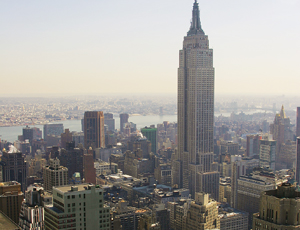While the owner of the 2.6-million-sq-ft Empire State Building gears up for a $500-million renovation, designed to cut energy costs by 38% and be a model for other green office-building retrofits, a construction firm that recently moved into its green ESB offices is releasing hard data on the 24,000-sq-ft retrofit. Skanska USA Building, which moved into its 32nd-floor space in November, reports it has reduced its energy bill by 46% over its smaller, previous offices elsewhere.

This fall, Skanska expects to be awarded LEED Platinum status for the retrofit from the U. S. Green Building Council’s Leadership in Energy and Environmental Design rating system. Of the project’s $4.6-million cost, $210,858 is attributed to the cost of a Class A office buildout with LEED improvements, which translates to $189.52 per sq ft, or $8.64 per sq ft more than non-LEED space. The predicted energy savings, coupled with a $22,802 grant from New York state, yields a gain of $368,380 over the course of the 15-year lease, after subtracting the LEED premium, says a spokesman for Skanska.
More than half the LEED points come from indoor environment and energy categories, according to Tri Tan, Skanska’s preconstruction director. Some 90% of the office gets daylight and 99% of employees have outside views. A raised-floor air system has operable diffusers that allow individuals to control workstation temperature. The menu of energy-savers includes automatic light dimmers, waterless urinals, low-flow toilets and hand-sensored faucets.
In April, Skanska’s landlord, Wein & Malkin, announced a retrofit for the 102-story tower, designed under an initiative to demonstrate that green retrofits and operations can reduce energy costs and greenhouse-gas emissions. The initial $20-million project, already under way, is expected to reduce energy use by 38% and energy costs by $4.4 million annually, down from $11.4 million, says the owner. In turn, that would reduce carbon-dioxide emissions by 105,000 metric tons over 15 years. Much of the project is funded through anticipated savings in the cost of energy and operations.
The initiative involves the Empire State Building Co. LLC; the Clinton Climate Initiative; Johnson Controls Inc., which is doing most of the engineering; Jones Lang LaSalle, program manager; and the Rocky Mountain Institute, a nonprofit energy-efficiency group. Projects outlined include replacing the 6,500 windows with insulated, double-paned glass—though the windows are less than 20 years old—and upgrading the building’s infrastructure, which would require tenants to monitor energy use. Most of the first phase of the work is expected to be completed in two years.


Post a comment to this article
Report Abusive Comment